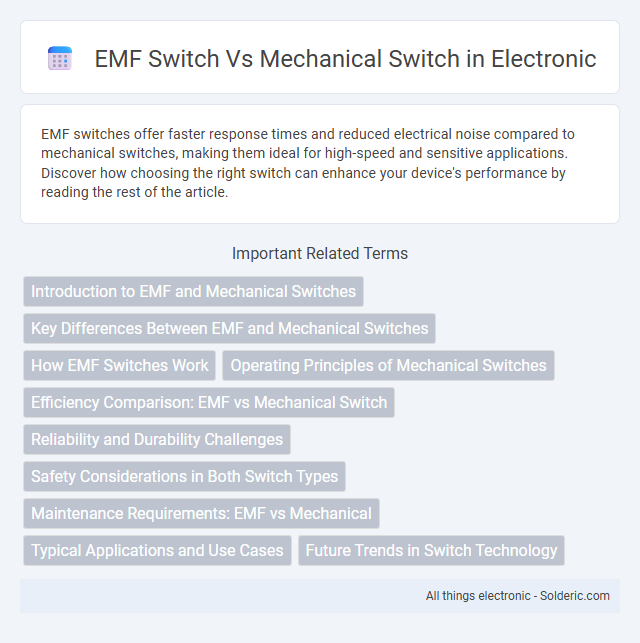EMF switches offer faster response times and reduced electrical noise compared to mechanical switches, making them ideal for high-speed and sensitive applications. Discover how choosing the right switch can enhance your device's performance by reading the rest of the article.
Comparison Table
| Feature | EMF Switch | Mechanical Switch |
|---|---|---|
| Operation | Uses electromagnetic force to open/close circuit | Physical contact toggles the circuit |
| Durability | High, fewer moving parts reduce wear | Moderate, prone to mechanical wear |
| Switching Speed | Fast electromagnetic switching | Slower due to manual actuation |
| Noise Level | Silent or low acoustic noise | Audible clicking sound |
| Power Consumption | Consumes power to maintain state (if relay-based) | No power consumption unless connected to load |
| Applications | Remote switching, automated control systems | Manual consumer electronics, simple circuits |
| Cost | Generally higher due to complexity | Lower, easier to manufacture |
Introduction to EMF and Mechanical Switches
EMF (Electromagnetic Field) switches use magnetic fields to open or close circuits without physical contact, enhancing durability and reducing wear compared to mechanical switches that rely on physical movement and contact points. Mechanical switches function through the manual displacement of components to complete or interrupt electrical circuits, which can lead to mechanical wear over time. Your choice between EMF and mechanical switches impacts device longevity and maintenance requirements due to their fundamentally different operating principles.
Key Differences Between EMF and Mechanical Switches
EMF switches operate using electromagnetic fields to open or close circuits, providing rapid, contactless switching with minimal wear compared to mechanical switches that rely on physical contacts and springs for operation. Mechanical switches often experience contact degradation and noise over time due to friction and arcing, while EMF switches offer enhanced durability and faster response times. Key differences include operational method, lifespan, switching speed, and maintenance requirements, making EMF switches preferable in high-speed, high-reliability applications.
How EMF Switches Work
EMF switches operate by detecting electromagnetic fields generated by electrical currents, allowing for contactless activation and deactivation of circuits. These switches rely on magnetic sensors or coils that respond to changes in electromagnetic flux, providing precise control without physical wear. Compared to mechanical switches, EMF switches offer enhanced durability, faster response times, and reduced maintenance due to their non-contact operation.
Operating Principles of Mechanical Switches
Mechanical switches operate by physically opening or closing electrical contacts through manual actuation, allowing or interrupting the flow of current. These switches rely on moving parts such as springs and metal contacts to establish a stable connection, providing tactile feedback and reliability in various applications. Your choice of a mechanical switch ensures straightforward functionality and durability due to its simple mechanical design.
Efficiency Comparison: EMF vs Mechanical Switch
EMF switches offer higher efficiency by reducing energy loss through contact resistance and minimizing mechanical wear, leading to improved durability and performance. Mechanical switches exhibit higher energy dissipation due to friction and physical contact degradation, which decreases switching speed and operational lifespan. EMF switches utilize electromagnetic fields to achieve faster switching with lower power consumption, making them more suitable for high-frequency applications.
Reliability and Durability Challenges
EMF switches offer enhanced reliability due to their contactless operation, eliminating wear and tear caused by physical movement typical in mechanical switches. Mechanical switches often face durability challenges from repeated mechanical stress and contact degradation, leading to eventual failure. Choosing an EMF switch for your application can significantly reduce maintenance needs and improve long-term performance under demanding conditions.
Safety Considerations in Both Switch Types
EMF switches generate electromagnetic fields that may pose minimal exposure risks, requiring shielding to ensure user safety, while mechanical switches rely on physical contacts that reduce electromagnetic interference but may wear out due to mechanical friction. Safety considerations for EMF switches include proper insulation and electromagnetic compatibility (EMC) standards to prevent unintended device activation or interference. Mechanical switches demand robust materials to prevent sparks and electrical shorts, crucial in hazardous environments where explosive gases or dust are present.
Maintenance Requirements: EMF vs Mechanical
EMF switches generally require less maintenance than mechanical switches due to their solid-state components, which reduce wear and tear from physical movement. Mechanical switches demand regular inspections and lubrication to prevent contact degradation and ensure reliable operation. Your choice between EMF and mechanical switches affects long-term maintenance efforts and operational costs.
Typical Applications and Use Cases
EMF switches are commonly used in applications requiring precise electronic control, such as home automation systems, smart lighting, and IoT devices, where silent operation and integration with digital networks are crucial. Mechanical switches find typical use in traditional settings like residential lighting, industrial machinery, and automotive dashboards due to their robust tactile feedback and reliability under varying environmental conditions. Your choice between an EMF switch and a mechanical switch should consider the specific operational environment and the need for either electronic compatibility or manual control.
Future Trends in Switch Technology
EMF switches leverage electromagnetic fields for contactless operation, reducing wear and enhancing durability compared to traditional mechanical switches that rely on physical contact and moving parts. Emerging trends emphasize integration with IoT devices, enabling remote control and smart automation through EMF switch technology. Advances in materials and miniaturization further push the future of switches toward higher sensitivity, lower power consumption, and increased reliability in industrial and consumer electronics.
EMF switch vs mechanical switch Infographic

 solderic.com
solderic.com